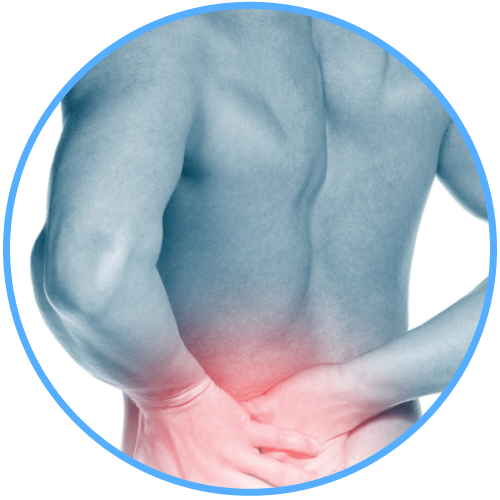
Hamstring strain
Hamstring muscle injuries — such as a “pulled hamstring” — occur frequently in the sporting population. They are especially common in athletes who participate in sports that require sprinting, such as rugby, hurling and football.
Hamstring muscles (there are three of them) start at the bottom of the pelvis. They cross the knee joint and end at the lower leg. Most hamstring injuries occur in the thick part of the muscle or where the muscle fibres join tendon fibres. There are typically two types of hamstring injuries proximal hamstring strain (High strain) and a distal hamstring strain (Low strain) both of which require physiotherapy treatment.
Treatment of hamstring strains depends on the type of injury and its severity. The goal of any treatment is to help you return to all the activities you enjoy, and help you prevent further problems in the future. Most hamstring strains heal very well with simple, non-surgical treatment.
- Most muscle strains initially treated with the RICE protocol. RICE stands for Rest, Ice, Compression, and Elevation.
- Therapeutic soft tissue techniques
- Therapeutic exercises (strengthening, stretching)
Hip Joint replacement
People with hip joint damage or irritation that causes pain and interferes with daily activities despite treatment may be candidates for hip replacement surgery. Osteoarthritis (OA) wear and tear of the joint is the most common cause of this type of damage.
Most patients begin exercising their hip the day after surgery as it can reduce stiffness and increase flexibility and muscle strength. A physiotherapist will teach you specific exercises to restore hip movement to allow walking and other normal daily activities soon after your surgery.
- Exercise programme to increase range of motion and strength
- A graduated walking program to slowly increase your mobility
- Education about reducing the stress on the hips and revision of post-surgery protocols
Sacroiliac joint dysfunction
Sacroiliac Joint Dysfunction is a condition in which pain is caused by the sacroiliac joint that connects the sacrum and the pelvis in you hip. Sacroiliac joint pain is believed to be caused by either too much movement (hypermobility) or too little movement (hypomobility) at the joint. This can be often seeing during pregnancy with hormonal regulation causing subtle changes on ligament laxity especially in the second and third trimester.
Physiotherapy treatments include
- Strengthening the core and lumbo/pelvic muscles with a graded exercise programme
- Education on provocative movement patterns such as getting in and out of the car
Piriformis syndrome
A neuromuscular disorder that occurs when the sciatic nerve is compressed or otherwise irritated by the piriformis muscle causing pain, tingling and numbness in the buttocks and along the path of the sciatic nerve descending the lower thigh and into the leg. This can be often caused by repetitive movements such as Irish dancing or gymnastics. Typical physiotherapy treatments include
- Stretching the hip muscles
- Reducing and gradually introducing the provocative activity
- Soft tissue release
Hip Impingement
A condition where the bones of the hip are abnormally shaped. Because they do not fit together perfectly, the hip bones rub against each other and cause damage to the joint. This can be often seen in GAA players being exposed to high levels of cutting and turning movements. Physiotherapy treatment includes settling the inflation and irritated structure through reducing the provocative activity and strengthening the hip muscles to cope with the dynamic forces more proficiently. Recent evidence suggests a period of physiotherapy treatment is best before surgery.
ITB syndrome
Iliotibial band syndrome is often referred to by other names – most commonly Runner’s Knee It is an overuse injury that occurs with repetitive movement e.g. running, cycling and comes as a result of inflammation and irritation of the distal portion of the iliotibial tendon as it rubs against the bone at the side of your knee. Inflammation may occur because of a lack of flexibility of the ITB resulting in an increase in tension in the knee area. ITBS can also arise as a result of muscle imbalance and weakness in the gluteal and core muscles.
Some Causes of Runner’s Knee / ITBS:
Iliotibial band syndrome is common in runners as 20 – 40 degrees is the approximate angle at the knee when the foot strikes the ground during running
Physiotherapy Treatment includes
- Soft tissue release to stretch the gluteal muscles
- Strengthening exercises to improve running biomechanical proficiency
- Gait analysis
Oseitis Pubis
An idiopathic, inflammatory disease of the pubic symphysis and surrounding structures. Osteitis pubis most commonly occurs among athletes but can also occur among non-athletes as a result of any pelvic stress. This is a common condition in GAA players with provocative movements such as turning and pivoting with increased training loads leading to inflammation of the pubis. This can be settled with reducing your training load and following a graded strengthening and training programme as instructed by your physiotherapist.



